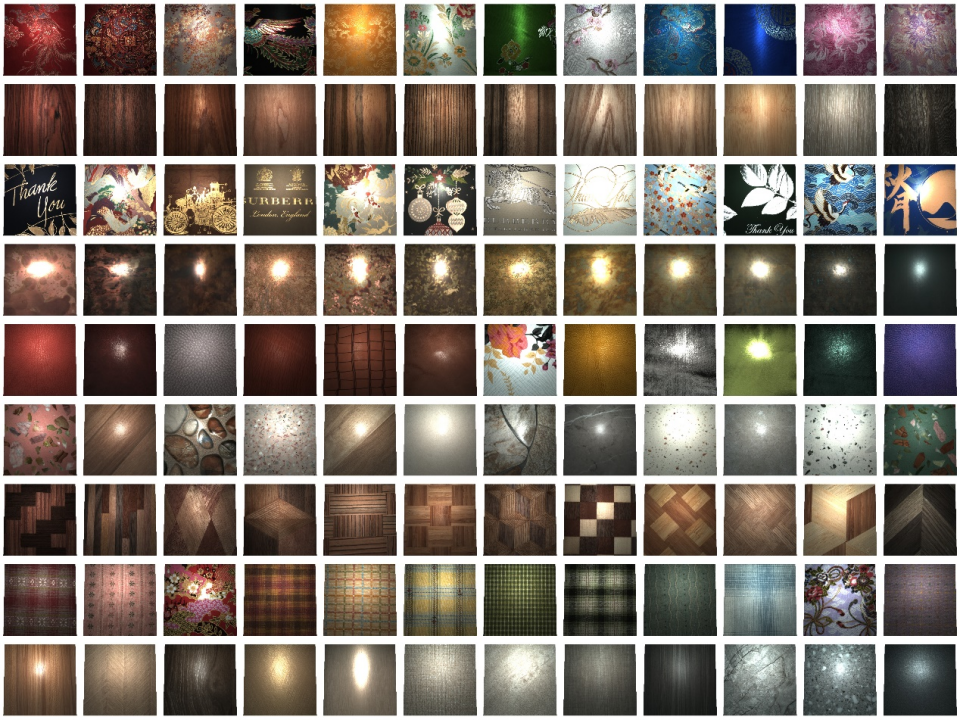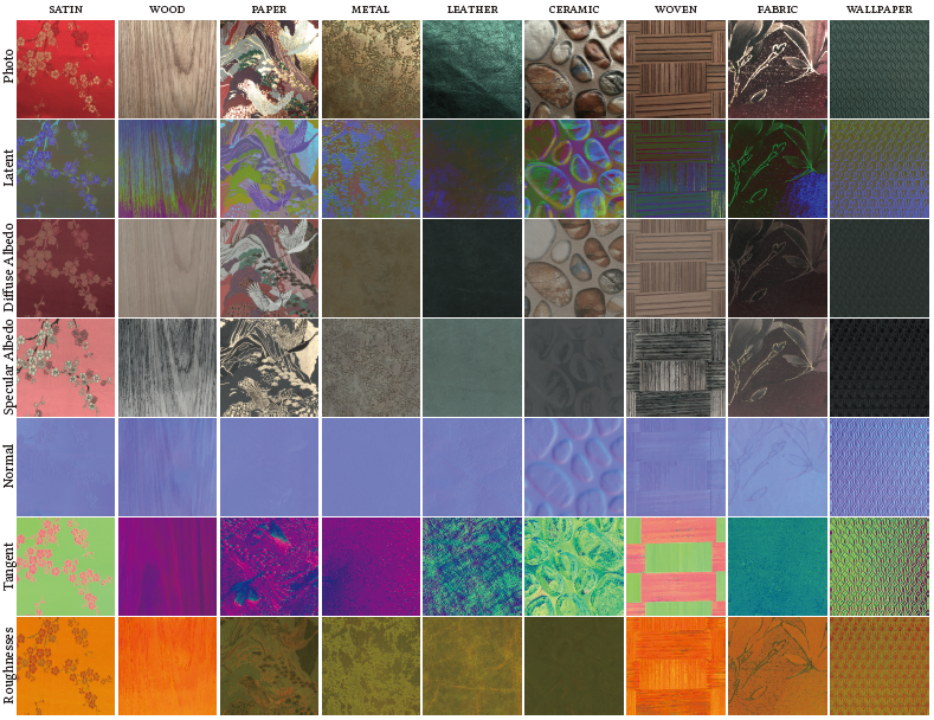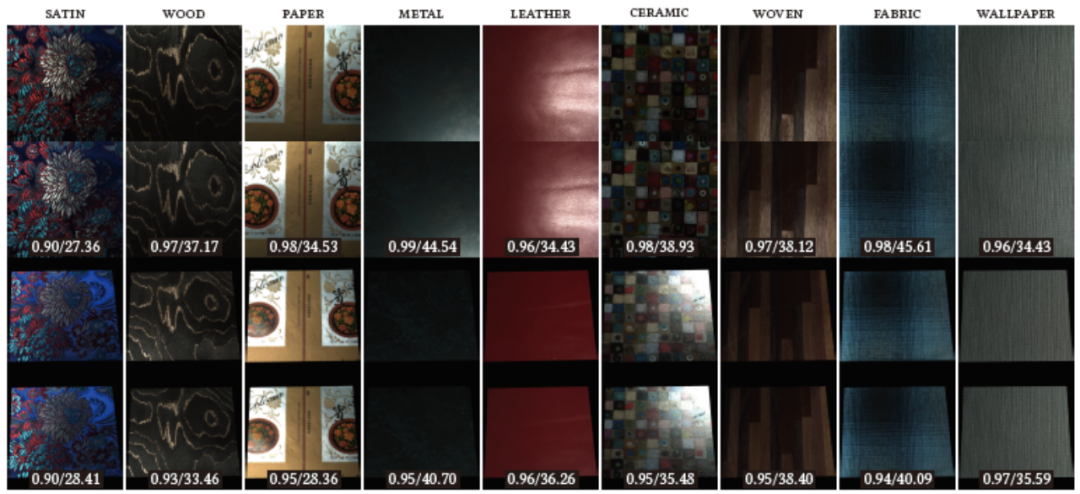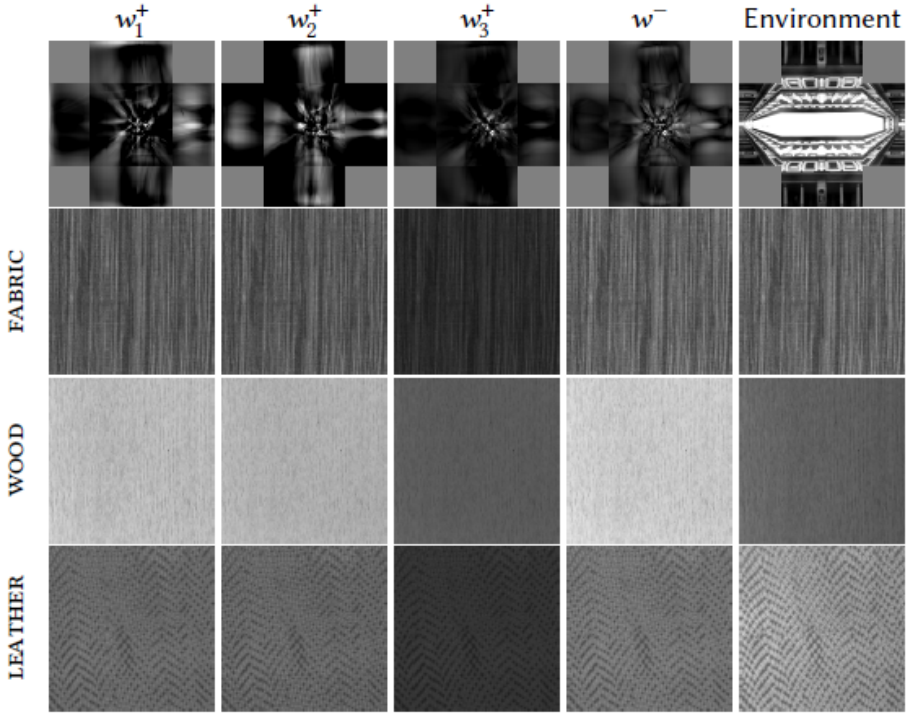 Technology peripherals
Technology peripherals
 AI
AI
 OpenSVBRDF released: a large-scale 6-dimensional material real-shot database at the ImageNet level in the material world
OpenSVBRDF released: a large-scale 6-dimensional material real-shot database at the ImageNet level in the material world
OpenSVBRDF released: a large-scale 6-dimensional material real-shot database at the ImageNet level in the material world
In the field of computational graphics, the appearance of a material describes the complex physical interactions between real objects and light. This description is often called a Spatially-Varying Bidirectional Reflectance Distribution Function (SVBRDF). It is an integral component in visual computing and has been widely used in fields such as cultural heritage, e-commerce, video games, and visual effects
over the past two decades , especially after deep learning became popular, the demand for high-precision and diverse digital material appearances in academia and industry has continued to increase. However, due to technical challenges, collecting large-scale databases is still a very difficult task. Currently, the number of publicly available material appearance real-shot databases is very limited
For this reason, Zhejiang University The research team from the National Key Laboratory of Computer-Aided Design and Graphics Systems and Hangzhou Xiangxin Technology Co., Ltd. jointly proposed a new integrated system for robust, high-quality and efficient acquisition of planar anisotropic material appearance. Using this system, the research team built the OpenSVBRDF public material database.

The following is a display of some material samples in the OpenSVBRDF database, as shown in Figure 1. Each row belongs to the same material category
This is the first large-scale measured database of 6-dimensional SVBRDF, with a total of 1,000 high-quality plane samples and a spatial resolution of 1,024×1,024. Equivalent to more than 1 billion measured BRDF, covering 9 categories including wood, fabric and metal.
Database home page: https://opensvbrdf.github.io/
Currently, the database is completely free for non-commercial applications. You only need to submit basic information on the website to apply for an account. After review, you can directly download relevant data and codes including GGX texture maps. The related research paper "OpenSVBRDF: A database containing measured spatially varying reflectivity" has been accepted by the top international conference on computer graphics ACM SIGGRAPH ASIA 2023 (journal paper)

Please click the following link to view the paper homepage: https://svbrdf.github.io/
Technical Challenges
If the original meaning is changed, the content that needs to be rewritten is: According to [Lawrence et al. 2006], the direct sampling method is to make dense measurements of the physical material under different lighting and viewing angles. Although this method can obtain high-quality and stable acquisition results, it is less efficient and requires a lot of time and storage costs. Another option is a prior knowledge-based reconstruction method, which can reconstruct materials from sparse sampled data. Although this method improves efficiency, the quality of reconstruction may be unsatisfactory when the prior conditions are not met [Nam et al. 2018]. In addition, although the current optical path multiplexing technology has achieved high acquisition efficiency and reconstruction quality, the robustness of the algorithm still needs to be improved in processing highly complex materials, such as brushed metal and polished veneer [Kang et al. 2018]

Figure 2: Representative work of existing material collection research. From left to right they are [Lawrence et al. 2006], [Nam et al. 2018] and [Kang et al. 2018]. Among them [Kang et al. 2018] is the team's early work published in ACM SIGGRAPH in 2018.
Hardware
In order to efficiently scan the material appearance, the research team built a near-half-cube near-field illumination multiplexing device. The size is approximately 70cm×70cm×40cm. The sample is placed on a clear acrylic plate and can be quickly slid in/out via drawer slides to achieve high throughput rates. The device consists of 2 machine vision cameras and 16,384 high-brightness LEDs. The two cameras capture samples from angles of approximately 90 degrees (primary viewing angle) and 45 degrees (secondary viewing angle). The LEDs are distributed on 6 sides of the device. The self-developed high-performance control circuit is responsible for independent brightness control of each LED and achieves high-precision synchronization of light source projection and camera exposure at the hardware level.

Please see Figure 3: The appearance of the acquisition equipment and the photos taken from two different angles
Acquisition and reconstruction
This system uniquely combines two currently popular methods, network-based prediction and fine-tuning, to improve the efficiency of physical acquisition. Optimization of differentiable lighting patterns while further improving the quality of results through fine-tuning. This is the first time to achieve high robustness, high quality and high efficiency of acquisition and reconstruction of planar SVBRDF
Specifically, in order to reconstruct the physical sample, the researchers first achieved this by Match dense SIFT features to establish high-precision correspondence between two camera views. For physical acquisition, the lighting pattern is first optimized as part of an autoencoder to achieve efficient acquisition. The autoencoder automatically learns how to reconstruct complex appearances based on measurements from two views and represents the results as intermediate neural representations. Subsequently, the neural expressions were fine-tuned by plotting image errors to improve the quality and robustness of the final results, based on photos taken by a principal-view camera under 63 equivalent linear light sources. Figure 3 shows the processing flow of the entire system. For details, please refer to the original paper

Figure 4: Acquisition and reconstruction process of the entire system.
Results
The research team collected appearance data and collected a total of 1,000 samples divided into 9 categories. To make it easier to use the physics-based rendering pipeline (PBR), the study also adapted neural expressions to industry-standard anisotropic GGX BRDF model parameters. Figure 5 shows the sub-parameters and properties of the material reconstruction results. Each sample contains 193 original HDR photos (total size 15GB), intermediate neural expressions (290MB), and 6 maps, including texture maps and transparency maps representing GGX parameters (total size 55MB). The spatial resolution of both neural expressions and texture maps is 1,024×1,024

After rewriting: Figure 5: Breakdown of reconstructed material results Properties (including neural expression, diffuse reflectance, specular reflectance, roughness, etc.)
In order to prove the correctness of the reconstruction results, the researchers took the photos from the main perspective (the picture below) First row) and neural expression mapping results (second row below) are compared. Quantitative errors (expressed as SSIM/PSNR) are noted at the bottom of the plot. As can be seen from the results in the figure below, this system achieves high-quality material reconstruction (SSIM>=0.97, PSNR>=34db).

Figure 6: Comparison of real photos and neural expression rendering results from the main perspective.
In order to further prove the generalization of the reconstruction results in the viewing angle domain, the researchers compared the photos taken from two viewing angles under the illumination of a point light source and the results drawn using GGX fitting parameters. The comparison verifies the cross-view correctness of the reconstruction results.

Picture 7: Comparison of actual photos taken and results drawn using anisotropic GGX fitting parameters in two viewing angles
The researchers also demonstrated the application of the database in three aspects: material generation, material classification and material reconstruction. Please refer to the original paper for specific details.

Figure 8 shows the process of using OpenSVBRDF to train MaterialGAN to achieve material generation and interpolation

Figure 9 shows the process of using OpenSVBRDF to train active lighting to improve material classification accuracy

Rewritten content is as follows: Picture 10: Using OpenSVBRDF to improve the quality of BRDF reconstruction based on single-point sampling (left) and optical path multiplexing (right)
Outlook
Researchers will work hard to expand the existing database and add material samples showing diverse appearances. In the future, they also plan to build a large-scale, high-precision measured object database that includes both material appearance and geometric shape. In addition, researchers will design a public benchmark in the direction of material estimation, classification and generation based on OpenSVBRDF, and provide solid data guarantee to promote the future development of related research through objective and quantitative standard testing.
The above is the detailed content of OpenSVBRDF released: a large-scale 6-dimensional material real-shot database at the ImageNet level in the material world. For more information, please follow other related articles on the PHP Chinese website!

Hot AI Tools

Undresser.AI Undress
AI-powered app for creating realistic nude photos

AI Clothes Remover
Online AI tool for removing clothes from photos.

Undress AI Tool
Undress images for free

Clothoff.io
AI clothes remover

Video Face Swap
Swap faces in any video effortlessly with our completely free AI face swap tool!

Hot Article

Hot Tools

Notepad++7.3.1
Easy-to-use and free code editor

SublimeText3 Chinese version
Chinese version, very easy to use

Zend Studio 13.0.1
Powerful PHP integrated development environment

Dreamweaver CS6
Visual web development tools

SublimeText3 Mac version
God-level code editing software (SublimeText3)

Hot Topics
 Oracle's Role in the Business World
Apr 23, 2025 am 12:01 AM
Oracle's Role in the Business World
Apr 23, 2025 am 12:01 AM
Oracle is not only a database company, but also a leader in cloud computing and ERP systems. 1. Oracle provides comprehensive solutions from database to cloud services and ERP systems. 2. OracleCloud challenges AWS and Azure, providing IaaS, PaaS and SaaS services. 3. Oracle's ERP systems such as E-BusinessSuite and FusionApplications help enterprises optimize operations.
 WorldCoin (WLD) price forecast 2025-2031: Will WLD reach USD 4 by 2031?
Apr 21, 2025 pm 02:42 PM
WorldCoin (WLD) price forecast 2025-2031: Will WLD reach USD 4 by 2031?
Apr 21, 2025 pm 02:42 PM
WorldCoin (WLD) stands out in the cryptocurrency market with its unique biometric verification and privacy protection mechanisms, attracting the attention of many investors. WLD has performed outstandingly among altcoins with its innovative technologies, especially in combination with OpenAI artificial intelligence technology. But how will the digital assets behave in the next few years? Let's predict the future price of WLD together. The 2025 WLD price forecast is expected to achieve significant growth in WLD in 2025. Market analysis shows that the average WLD price may reach $1.31, with a maximum of $1.36. However, in a bear market, the price may fall to around $0.55. This growth expectation is mainly due to WorldCoin2.
 What does cross-chain transaction mean? What are the cross-chain transactions?
Apr 21, 2025 pm 11:39 PM
What does cross-chain transaction mean? What are the cross-chain transactions?
Apr 21, 2025 pm 11:39 PM
Exchanges that support cross-chain transactions: 1. Binance, 2. Uniswap, 3. SushiSwap, 4. Curve Finance, 5. Thorchain, 6. 1inch Exchange, 7. DLN Trade, these platforms support multi-chain asset transactions through various technologies.
 What is the analysis chart of Bitcoin finished product structure? How to draw?
Apr 21, 2025 pm 07:42 PM
What is the analysis chart of Bitcoin finished product structure? How to draw?
Apr 21, 2025 pm 07:42 PM
The steps to draw a Bitcoin structure analysis chart include: 1. Determine the purpose and audience of the drawing, 2. Select the right tool, 3. Design the framework and fill in the core components, 4. Refer to the existing template. Complete steps ensure that the chart is accurate and easy to understand.
 How to win KERNEL airdrop rewards on Binance Full process strategy
Apr 21, 2025 pm 01:03 PM
How to win KERNEL airdrop rewards on Binance Full process strategy
Apr 21, 2025 pm 01:03 PM
In the bustling world of cryptocurrencies, new opportunities always emerge. At present, KernelDAO (KERNEL) airdrop activity is attracting much attention and attracting the attention of many investors. So, what is the origin of this project? What benefits can BNB Holder get from it? Don't worry, the following will reveal it one by one for you.
 Aavenomics is a recommendation to modify the AAVE protocol token and introduce token repurchase, which has reached the quorum number of people.
Apr 21, 2025 pm 06:24 PM
Aavenomics is a recommendation to modify the AAVE protocol token and introduce token repurchase, which has reached the quorum number of people.
Apr 21, 2025 pm 06:24 PM
Aavenomics is a proposal to modify the AAVE protocol token and introduce token repos, which has implemented a quorum for AAVEDAO. Marc Zeller, founder of the AAVE Project Chain (ACI), announced this on X, noting that it marks a new era for the agreement. Marc Zeller, founder of the AAVE Chain Initiative (ACI), announced on X that the Aavenomics proposal includes modifying the AAVE protocol token and introducing token repos, has achieved a quorum for AAVEDAO. According to Zeller, this marks a new era for the agreement. AaveDao members voted overwhelmingly to support the proposal, which was 100 per week on Wednesday
 Ranking of leveraged exchanges in the currency circle The latest recommendations of the top ten leveraged exchanges in the currency circle
Apr 21, 2025 pm 11:24 PM
Ranking of leveraged exchanges in the currency circle The latest recommendations of the top ten leveraged exchanges in the currency circle
Apr 21, 2025 pm 11:24 PM
The platforms that have outstanding performance in leveraged trading, security and user experience in 2025 are: 1. OKX, suitable for high-frequency traders, providing up to 100 times leverage; 2. Binance, suitable for multi-currency traders around the world, providing 125 times high leverage; 3. Gate.io, suitable for professional derivatives players, providing 100 times leverage; 4. Bitget, suitable for novices and social traders, providing up to 100 times leverage; 5. Kraken, suitable for steady investors, providing 5 times leverage; 6. Bybit, suitable for altcoin explorers, providing 20 times leverage; 7. KuCoin, suitable for low-cost traders, providing 10 times leverage; 8. Bitfinex, suitable for senior play
 The top ten free platform recommendations for real-time data on currency circle markets are released
Apr 22, 2025 am 08:12 AM
The top ten free platform recommendations for real-time data on currency circle markets are released
Apr 22, 2025 am 08:12 AM
Cryptocurrency data platforms suitable for beginners include CoinMarketCap and non-small trumpet. 1. CoinMarketCap provides global real-time price, market value, and trading volume rankings for novice and basic analysis needs. 2. The non-small quotation provides a Chinese-friendly interface, suitable for Chinese users to quickly screen low-risk potential projects.





